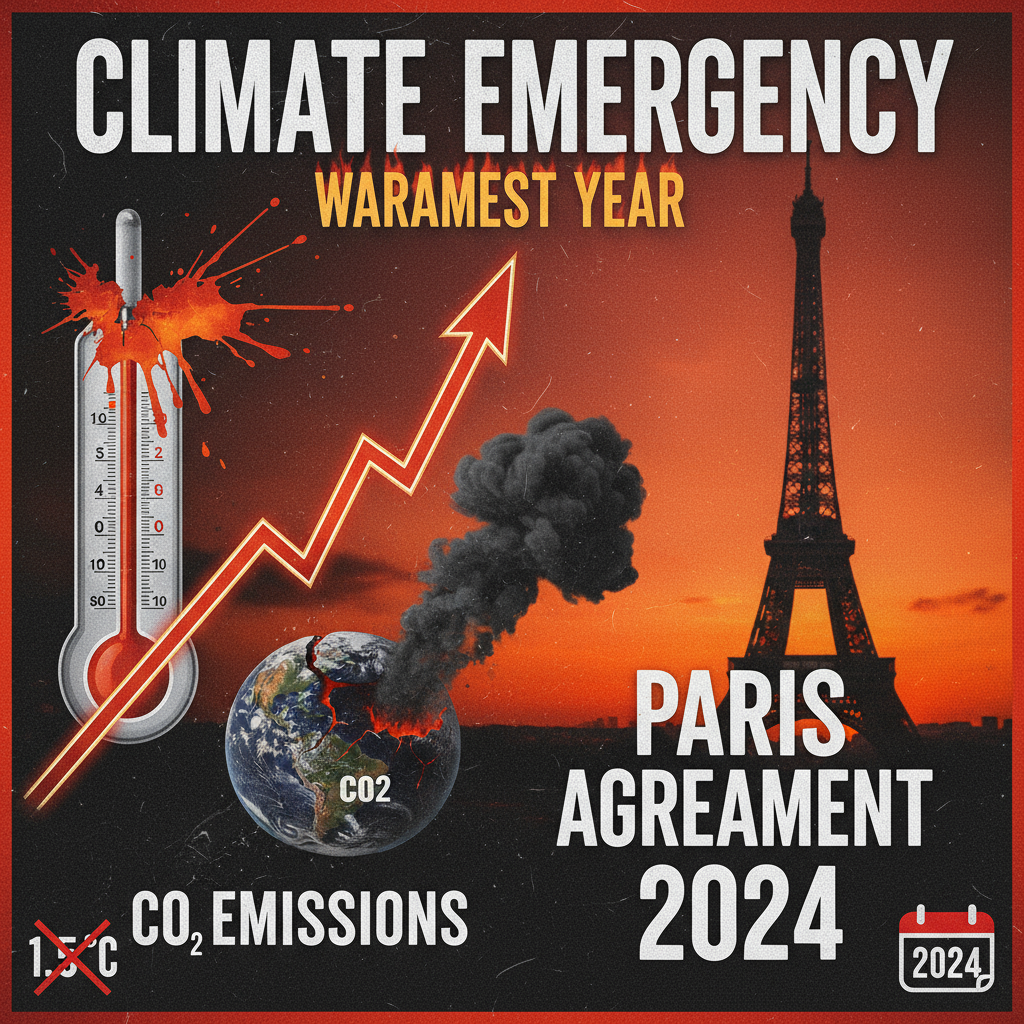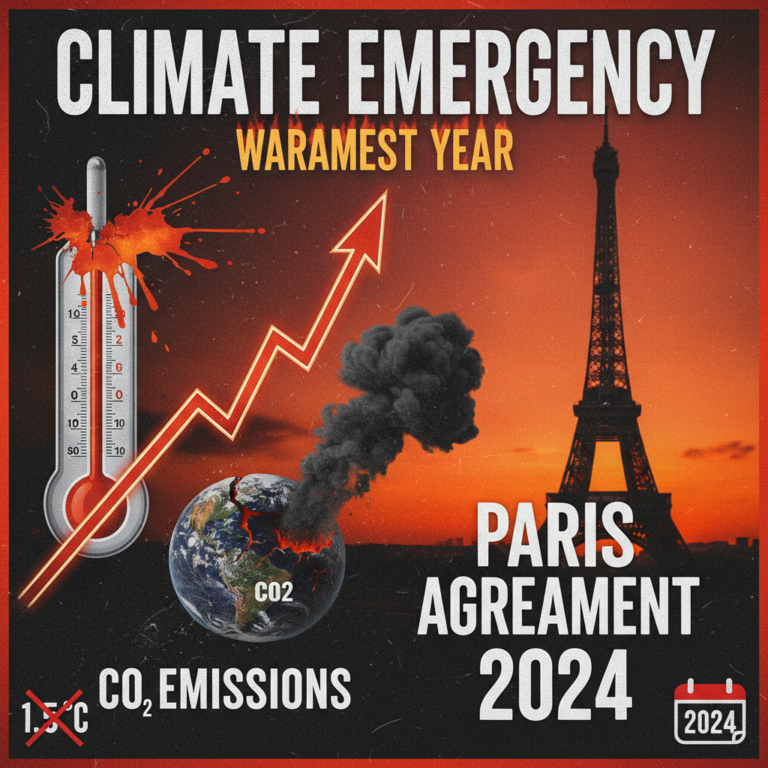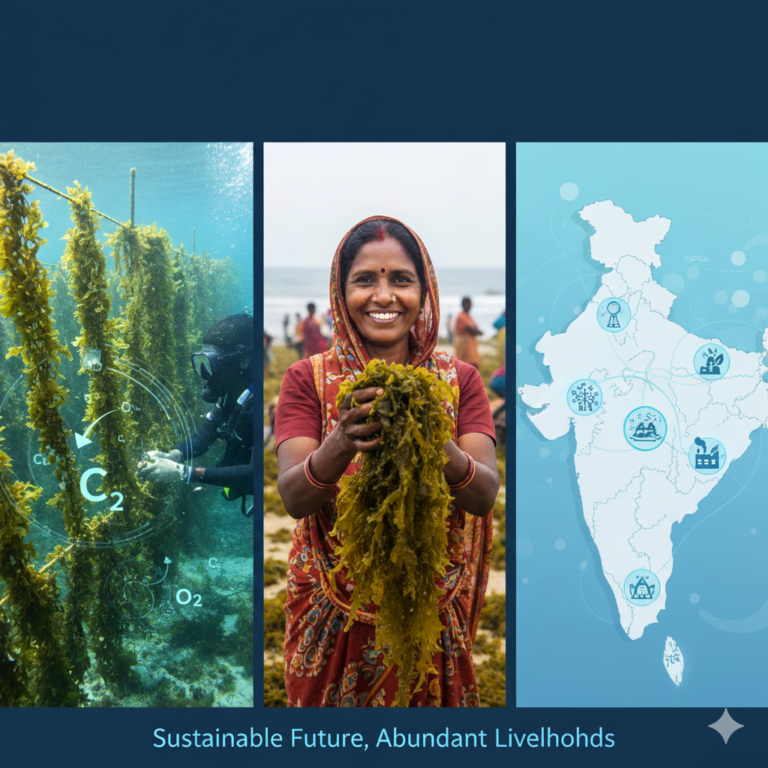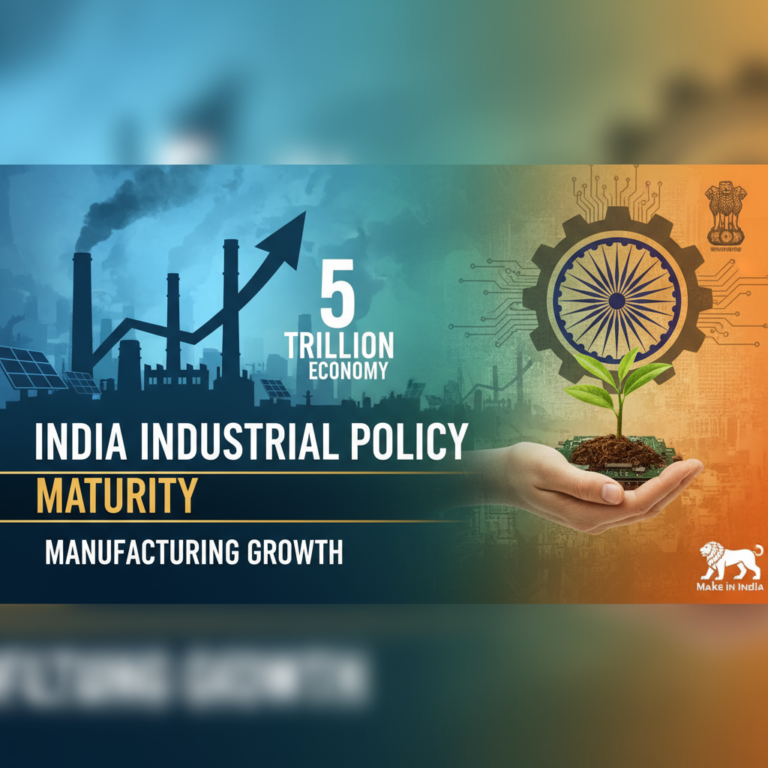Source: WMO Report
Key Highlights
- Historic COâ‚‚ Spike: 423.9 ppm in 2024 (152% of pre-industrial) with unprecedented 3.5 ppm increase – triple the 1960s rate (0.8 ppm/year) and above 2011-2020 average (2.4 ppm/year)​
- 1.5°C Threshold Breached: 2024 becomes first full year exceeding 1.5°C warming (1.55°C above 1850-1900) though Paris Agreement targets long-term average​
- Carbon Sink Collapse: El Niño 2024 causing tropical forest loss double that of 2023; Amazon, forests, oceans absorbing less COâ‚‚ creating “vicious cycle”​
- India’s Dual Challenge: Emissions grew 6.1% to 4,140 MtCOâ‚‚e (2023); 3rd largest emitter globally but pursuing net-zero 2070, 500 GW non-fossil capacity by 2030​
- Urgent Action Gap: Current policies lead to 2.6°C warming by 2100; need 43% emissions cut by 2030, 57% by 2035 to preserve 1.5°C pathway​
The Alarming Numbers: Decoding WMO’s Greenhouse Gas Bulletin
On October 14, 2025, the World Meteorological Organization released its 21st annual Greenhouse Gas Bulletin revealing atmospheric COâ‚‚ concentrations reached 423.9 parts per million in 2024 – the highest level in over 2 million years and 152% of pre-industrial concentrations.​
But the more concerning metric is the rate of increase: From 2023 to 2024, COâ‚‚ surged by 3.5 ppm – the largest annual jump since systematic measurements began in 1957. This represents a dramatic acceleration: newscientist​
1960s: 0.8 ppm/year average increase
2011-2020 decade: 2.4 ppm/year average
2022-2023: 2.3 ppm increase
2023-2024: 3.5 ppm increase (53% jump from recent average)
“The heat trapped by COâ‚‚ and other greenhouse gases is turbo-charging our climate and leading to more extreme weather,” warned WMO Deputy Secretary-General Ko Barrett. “Reducing emissions is therefore essential not just for our climate but also for our economic security and community well-being.”​
2024: The Year We Crossed 1.5°C

Coinciding with record COâ‚‚ levels, 2024 became the warmest year in recorded history with global average temperature reaching 1.55°C above pre-industrial levels (1850-1900 baseline) – the first full calendar year to breach the critical 1.5°C threshold. wmo​
Six independent datasets confirmed this milestone:​
- Copernicus Climate Change Service: 1.6°C above pre-industrial
- WMO composite: 1.55°C (average across all datasets)
- NASA, NOAA, UK Met Office, JMA: All confirming 2024 as warmest year
This surpassed the previous record holder – 2023 – which was 1.45°C above pre-industrial levels. Every month from July 2023 onwards (except July 2024) exceeded 1.5°C above pre-industrial averages.​
Does This Mean Paris Agreement Has Failed?
Not technically – but the window is rapidly closing. The Paris Agreement’s 1.5°C target refers to long-term averages over decades, not single years. Current long-term average warming is estimated at 1.34°C to 1.41°C depending on measurement methodology.​
However, WMO forecasts an 86% chance that at least one year between 2025-2029 will exceed 1.5°C, and 70% probability that the five-year average will breach this threshold. Recent climate modeling suggests we may have already entered the 20-year period where average temperatures permanently exceed 1.5°C. news.un​
“Every fraction of a degree of warming matters,” emphasized WMO Secretary-General Celeste Saulo. “Whether it is below or above 1.5°C, every additional increment increases impacts on our lives, economies and planet.”​
The Vicious Cycle: When Carbon Sinks Become Carbon Sources

Perhaps the most alarming finding in the WMO bulletin is the weakening capacity of Earth’s natural carbon “sinks” to absorb COâ‚‚ from the atmosphere.​
Normally, terrestrial ecosystems (forests, soils) and oceans absorb approximately half of anthropogenic COâ‚‚ emissions. But 2024’s El Niño conditions created a triple threat:
1. Forest Carbon Absorption Collapse
Tropical forest loss in 2024 was double that of 2023. The Amazon rainforest – traditionally a massive carbon sink – experienced:​
- Record heat stress reducing photosynthesis
- Drought conditions limiting tree growth
- Increased wildfire emissions
- Trees shifting from carbon sinks to carbon sources in extreme conditions
2. Ocean Warming Effects
Warmer ocean waters absorb less COâ‚‚ due to reduced solubility. Surface ocean warming also strengthens stratification, limiting vertical mixing that brings nutrients to support carbon-absorbing phytoplankton.
3. Wildfire Emission Surge
2024’s record heat fueled catastrophic wildfires globally, not only destroying carbon-storing vegetation but directly emitting stored carbon back into the atmosphere. The bulletin cited wildfires as a major contributor alongside fossil fuel emissions.​
“This threatens to be a vicious climate cycle,” the WMO warned. Reduced carbon sink capacity → higher atmospheric COâ‚‚ → more warming → further sink degradation → even higher COâ‚‚. This positive feedback loop accelerates climate change beyond what emissions alone would cause.​
India’s Climate Conundrum: Growth vs. Emissions

India faces unique challenges as both a vulnerable developing nation and the world’s third-largest emitter (after China and US). climateactiontracker
Emissions Status 2023
Total GHG Emissions: 4,140 MtCOâ‚‚e (2023) – 6.1% increase from 2022​
Per Capita: Still significantly lower than developed nations
Historical Cumulative: Much lower than US/EU despite current ranking
Growth Driver: Economic development, industrialization, urbanization lifting millions from poverty
Panchamrit Pledges: India’s Climate Commitments
At COP26 Glasgow (November 2021), Prime Minister Narendra Modi announced “Panchamrit” (five nectar elements) of India’s climate action: pib.gov​
1. 500 GW Non-Fossil Capacity by 2030: Current progress shows renewables supplying nearly one-third of additional electricity generation in 2024-25​
2. 50% Energy from Renewables by 2030: Shift already visible – 2024-25 marked turning point when non-fossil sources contributed majority of new generation​
3. 1 Billion Tonnes CO₂ Reduction: From projected levels between now and 2030​
4. 45% Emissions Intensity Cut: Below 2005 levels by 2030​
5. Net-Zero by 2070: Long-term commitment recognizing India’s development needs while contributing to global climate action​
Current Progress and Challenges
Renewable Energy Expansion: Fastest-growing among G20 nations; solar and wind targeted to deliver 38% of needed emission reductions by 2035​
Coal Dependency: Despite progress, coal’s share fell to 47% of installed capacity in 2024, but absolute fossil fuel use continues rising as demand grows​
Investment Surge: Record renewable investments; over 73 GW of solar and wind capacity tendered; rooftop solar expanding rapidly​
Policy Gap: NEP2023 (National Electricity Plan) implementation slower than projected – over 100 GW additional renewable capacity needed by 2026-27 to meet interim 350 GW milestone​
The Fundamental Challenge: India’s rising electricity demand historically outpaced renewable growth, forcing annual fossil fuel increases. 2024-25 breakthrough showed renewables can meet majority of new demand – but large-scale coal transition still requires strong policy push beyond market forces.​
Global Emissions Gap: The Widening Chasm
Current global greenhouse gas emissions: 57.1 gigatons COâ‚‚e (2023) – 1.3% increase from 2022, representing new record​
G20 Responsibility: 77% of global emissions​
To preserve 1.5°C pathway, the world must:​
- Cut emissions 43% by 2030 (from current levels)
- Cut emissions 57% by 2035
- Reach net-zero around 2050
Current trajectory under existing policies: 2.6°C warming by 2100 – double the Paris Agreement’s “well below 2°C” target​
The emissions gap – difference between current pathway and 1.5°C pathway – continues widening despite growing awareness and climate pledges.
COP30 and Policy Imperatives
The WMO bulletin was released strategically ahead of COP30 in Belém, Brazil (November 2025), where nations must dramatically ratchet up ambition.​
Key Policy Actions Needed
Fossil Fuel Phase-Out: Despite being primary driver, coal, oil, gas expansion continues. Just transitions crucial for emerging economies dependent on fossil revenues and employment​
Carbon Sink Protection and Restoration: Strengthen forests, mangroves, grasslands, blue carbon ecosystems. Amazon protection critical – its degradation from sink to source would catastrophically accelerate warming​
Climate Finance: Developed nations must deliver promised $100+ billion annually to developing countries for mitigation and adaptation. India specifically called for $1 trillion climate finance at COP26​
Technology Transfer: Accelerate clean energy, carbon capture, climate resilience technology deployment in Global South​
Monitoring and Transparency: “Sustaining and expanding greenhouse gas monitoring are critical,” emphasized Oksana Tarasova, Greenhouse Gas Bulletin coordinator. Science-driven action requires comprehensive, transparent data.​
India-Specific Vulnerabilities and Adaptation
Beyond mitigation, India faces severe climate impact vulnerabilities:
Heatwaves: 2024 saw record-breaking temperatures affecting hundreds of millions; deadly for vulnerable populations, threatening outdoor work
Water Stress: Changing monsoon patterns, glacier melt, groundwater depletion creating agricultural and urban water crises
Coastal Risks: Sea-level rise threatening coastal communities, infrastructure; saltwater intrusion affecting agriculture
Agricultural Shocks: Erratic rainfall, temperature stress impacting crop yields, food security for 1.4+ billion people
Extreme Events: Floods, cyclones, droughts increasing in frequency and intensity
Adaptation imperatives include:
- Early warning systems (India has improved significantly)
- Climate-resilient agriculture and crop varieties
- Water management and conservation infrastructure
- Urban climate adaptation and green infrastructure
- Ecosystem-based adaptation protecting natural buffers
Governance and Policy Dimensions
For civil service aspirants, the 2024 CO₂ record and 1.5°C breach raise critical governance questions:
Federalism and Climate Action: How to coordinate central policies (net-zero 2070) with state-level implementation given energy, land use, agriculture being state subjects?
Development vs. Environment Balance: How does India pursue rapid economic growth, poverty alleviation while decarbonizing? Is “climate justice” argument of differentiated responsibilities still valid?
International Relations: How should India position itself in climate negotiations – as vulnerable developing nation or major emitter? Balance between demanding climate finance and demonstrating leadership?
Energy Security: Transition from coal while ensuring affordable, reliable power for manufacturing competitiveness and household access?
Technological Sovereignty: Reduce dependence on imported clean energy technology while accelerating deployment?
Social Justice: Ensuring just transitions for coal-dependent communities; preventing green policies from disproportionately burdening poor?
Science-Policy Interface: Strengthening climate science infrastructure, integrating scientific findings into policymaking, countering denialism?
Conclusion: The Decade of Decision

The 423.9 ppm COâ‚‚ concentration and 3.5 ppm record increase in 2024 represent more than alarming statistics – they signal accelerating climate change outpacing policy responses. The first-ever breach of 1.5°C warming threshold, even if temporary, demonstrates how perilously close we are to irreversible tipping points.​
The weakening of carbon sinks – from El Niño-stressed Amazon forests to warming oceans – introduces terrifying feedback loops where nature’s carbon absorption capacity collapses precisely when we need it most. This vicious cycle transforms climate change from linear threat to exponential crisis.​
For India, the challenge is acute: As the world’s third-largest emitter with 4,140 MtCOâ‚‚e growing 6.1% annually, while simultaneously being among nations most vulnerable to climate impacts and having hundreds of millions still needing development. The Panchamrit pledges – net-zero by 2070, 500 GW non-fossil capacity by 2030 – are ambitious, but current policy implementation shows gaps.​
The emissions gap remains stark: Current policies trajectory leads to 2.6°C warming by 2100, while preserving 1.5°C requires 43% global emission cuts by 2030 and 57% by 2035. Every year of delay makes the required transformation steeper, costlier, more disruptive.​
The 2024 records underscore that climate change is no longer future threat but present emergency demanding integration across all policy domains – energy, agriculture, urban planning, health, disaster management, foreign policy, finance. The next decade will determine whether humanity prevents catastrophic warming or adapts to a fundamentally altered planet.









+ There are no comments
Add yours